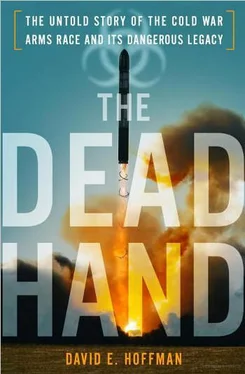This was a critical moment of confusion for the Soviets. They had been tracking the RC-135 by radar. When the missile test didn’t happen, the RC-135 headed back to its base on Shemya Island, but Soviet radar didn’t see it turn and go home. On the way home, the RC-135 crossed the flight path of the 747 at one point. The Soviet radar somehow lost the RC-135 and picked up the 747, now unexpectedly heading directly for Kamchatka. The plane was given a number, 6065, and the track was annotated with an “81,” which meant one unidentified aircraft. 2It was the off-course Korean Air Lines flight, but the Soviet ground controllers thought it might be an RC-135. The radar tracked the plane as it approached Kamchatka, but not constantly. Radar contact was lost, and picked up again while the plane was about halfway over the peninsula.
When the airliner approached Kamchatka, Soviet air defense forces were slow to react. Controllers were groggy, commanders had to be awakened, and there were radar gaps. Transcripts of ground control conversations show they spotted the plane just as it flew over the air defense forces base at Yelizovo. They scrambled four interceptors. These planes zigzagged in the air for twenty minutes but could not find the jet, which was actually north of them, and they were forced to return to base. The plane flew on, straight out over the Sea of Okhotsk and toward Sakhalin Island, about seven hundred miles away. Radar contact was lost at 1:28 A.M.
The plane appeared again on Sakhalin Island radars at 2:36 A.M. Once again it was given the track number 6065. However, this time the annotation was changed to “91,” which meant one military aircraft.
The command post duty officer at the Su-15 regiment at Sokol tried that night to use a long-distance phone operator to reach a radar station, Burevestnik. Located on Iturup Island in the Kurils, Burevestnik had sent a message saying that a target was approaching Sakhalin. 3
“Good morning,” the duty officer said to the long-distance operator, giving his secret code word, Oblako 535, and asking her to put through an urgent call to Burevestnik.
“Yes, high priority, urgent,” he insisted when she asked for the code again.
“Very well, wait,” she told him.
She asked for his phone number, then for his name. He gave it, and she didn’t understand.
He gave it again. He impatiently clicked on the receiver.
Four minutes passed. “There is no answer,” she replied.
“No answer?”
“No.”
“But why?”
“I don’t know why, there is no answer.”
“Did Burevestnik not answer?”
“There was no answer at the number at Burevestnik.”
“That cannot be…”
The operator asked, “What is that? What kind of organization is that?”
“It’s a military organization,” the duty officer said. “I need it now, operator, whatever it takes, but I must call there. It’s a matter of national importance. I’m not joking.”
“Just a minute. Just a minute.”
Five minutes after he started making the call, with the airliner flying eight miles a minute toward Sakhalin, the command post duty officer asked, “Well, what [is happening], eh?”
“Calling, no answer.”
Osipovich was napping at Sokol when the airliner approached Sakhalin. He was on duty, having taken the night shift so he could have the next day free; it was the first day of school and he was supposed to speak at his daughter’s class on the theme of “peace.” He ate and then dozed off watching television, and then awoke to check the guard.
Unexpectedly, the phone rang as he was getting dressed. He was ordered to rush out to the Su-15 and prepare for takeoff. The weather was poor as a frontal system rolled into Sakhalin. At 2:42 A.M. Osipovich ran to the plane and took off, flying toward the ocean, climbing to 26,000 feet. His call sign was “805.” Soon another Su-15 was in the air, and then a MiG 23 from the Smirnykh air base, also on Sakhalin. Osipovich had no idea what was going on; perhaps it was an elaborate training mission?
Soviet radar had resumed tracking the airliner and given it the same number as before, 6065. The conversations among ground controllers show they thought it might be an RC-135, although some had doubts. Not once in all the ground conversations nor in the transmissions to the pilots did anyone mention a Boeing 747. They directed Osipovich minute by minute toward the target, and told him: “The target is military, upon violation of State border destroy the target. Arm the weapons.”
Osipovich at first could only see the target as a dot, two or three centimeters. He had studied the RC-135s and knew the various Soviet civilian airliners, but he later recalled he had never studied the shape of foreign aircraft such as the Boeing 747.
A ground controller speculated, “If there are four jet trails, then it is an RC-135.” The 747 also had four engines.
“805, can you determine the type?” Osipovich was asked by the ground controller.
“Unclear,” he said.
Confusion reigned on the ground. No one wanted to be responsible for allowing another intrusion like the one on April 4. The Sokol command post duty officer, speaking to a superior, was asked if the incident was serious. “Yes, it looks serious, like on the fourth, but a bit worse,” he replied.
At 3:09 A.M. an order was given to destroy the plane, but then rescinded. The Sokol command post duty officer wondered if the Americans would really fly a spy plane directly into Soviet airspace. They usually circled outside territorial waters. “Somehow this all looks very suspicious to me,” he said. “I don’t think the enemy is stupid, so… Can it be one of ours?”
He called another command center at Makarov, on the eastern tip of the island, to see what they knew about the plane’s flight. “It hasn’t bombed us yet,” was the reply.
As he closed on the 747, about fifteen miles behind it, Osipovich saw his missile lock-on light illuminate. Yolki palki! he said, meaning “What the hell!” He turned off the missile lock-on and flew closer.
At 3:14 A.M., the commander of the Far East Military District was given a report. He was told Osipovich was ready to fire, but “he cannot identify it visually because it is still dark.”
“We must find out, maybe it is some civilian craft or God knows who,” said the commander.
“The pilot sees only a shadow,” said another ground controller.
“He cannot determine the type?”
“No way…it is dark, dark.”
Osipovich was now getting closer, 7.4 miles behind the airliner, which crossed Sakhalin. “It is flying with flashing lights,” he reported. Shortly after 3:12, Osipovich tried to contact the airliner by the Soviet friend-or-foe electronic identification system, but there was no response because the plane was civilian and did not carry a compatible military responder.
The Soviet ground controllers asked Osipovich six times whether the airliner was showing navigation lights, on the assumption that a plane without them might be on a spy mission. At 3:18, Osipovich reported, “The air navigation light is on, the flashing light is on.”
The Sokol ground controller told Osipovich to flash his lights briefly as a warning, and he did. Then, at 3:20, he was ordered to shoot a warning burst from his cannons. He did. There was no response. Then, unexpectedly, the airliner seemed to slow.
Unbeknownst to the Soviets, at 3:20, air traffic controllers in Tokyo had given Captain Chun permission to climb from 33,000 to 35,000 feet, and this caused the airliner to slow. Cockpit voice recordings show Chun and his crew never knew what was happening around them. Investigators later concluded that the change in altitude was seen by the Soviets as an evasive action and reinforced the suspicion that it was an RC-135 spy plane.
Читать дальше












